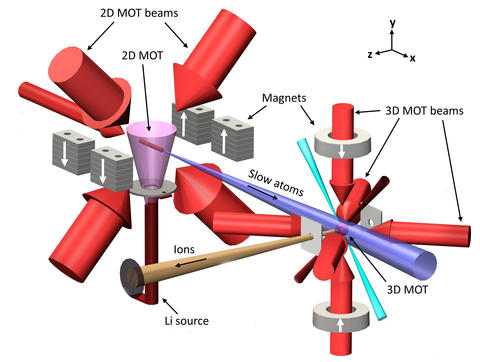
Schematic of the apparatus used to generate an improved lithium ion source.
Eight years ago, NIST researchers developed a groundbreaking microscope that uses a narrow beam of low-energy lithium ions, rather than a beam of light or electrons, to image and analyze materials. Now the same team has developed a much more intense source of lithium ions for the focused ion beam (FIB) microscope, greatly increasing the instrument’s potential to record images and analyze the structure of material with nanoscale precision.
Lithium ion beams are also used to implant the ions in lithium ion battery materials. The sharper, more concentrated beam should allow researchers to more rapidly and precisely implant the ions. Tracking the implanted ions as they move through a battery’s electrode provides a way to study the nanoscale behavior of the device, revealing new details about how electrodes swell and break down, and suggesting strategies for boosting the battery’s shelf life.
NIST scientists Jamie R. Gardner, William R. McGehee and Jabez J. McClelland described their work in the February 20 issue of the Journal of Applied Physics.
Whether it’s used as a microscope or to implant ions, the utility of a FIB depends on its ability to deliver a large number of ions into a small spot, Gardner said.
To develop a brighter and concentrated source of low-energy lithium ions, the researchers modified the multi-step process in which a vapor of neutral lithium atoms is created and transformed into a well-collimated beam of ions.
Once they are vaporized, the lithium atoms are moving too fast to be directly captured. In the original setup, a device known as a Zeeman slower used a combination of lasers and magnetic fields to slow the neutral atoms before they enter the main trapping and cooling apparatus. That apparatus, a magneto-optical trap, or MOT, uses lasers tuned to just the right frequency to make the atoms stationary, and a three-dimensional array of magnetic fields to confine them.
The new design eliminates the Zeeman slower, reducing the size of the system and making the lithium FIB less prone to unwanted vibrations. Instead, the vapor of fast-moving lithium atoms is directed into a 2D MOT that magnetically corrals the atoms in just two dimensions before they stream into a 3D MOT. The two-dimensional MOT delivers an intense beam of slow neutral atoms into the three-dimensional trap. The high intensity of neutral atoms translates into a higher lithium ion current.
The team also changed the way they ionized the cloud of neutral lithium atoms to form a collimated beam. Previously, the researchers ionized the atoms by sending a beam of ultraviolet laser light that traversed the entire volume of the three-dimensional MOT. Because the beam ionized neutral atoms throughout the MOT instead of from one particular spot, the vapor of neutral atoms quickly drained away and made it difficult to replenish the supply. This ultimately limited the maximum current of ions that could be generated in the focused beam.
In the new design, the researchers use two crossed laser beams that ionize only a small volume of the vapor at any one time, depleting fewer neutral atoms. Because the technique doesn’t require as many atoms to be replenished, the scientists were able to generate a more intense beam, which translates into a better FIB microscope. The team attained a maximum lithium ion current of 1 nanoamp, about 20 times higher than had been generated with the older design.
The higher current and smaller spot size of the ion beam mean that implantation of lithium ions in battery materials can be reduced from some 9 hours to 10 minutes, McClelland noted
The study highlighted that the transport of atoms within the vapor and the method of ionization are key factors that affect overall quality of the focused lithium ion beam, McGehee said.
Paper: Characterization of a high-brightness, laser-cooled Li+ ion source. J.R. Gardner, W.R. McGehee and J.J. McClelland. Journal of Applied Physics 125, 074904 (2019); https://doi.org/10.1063/1.5085068

